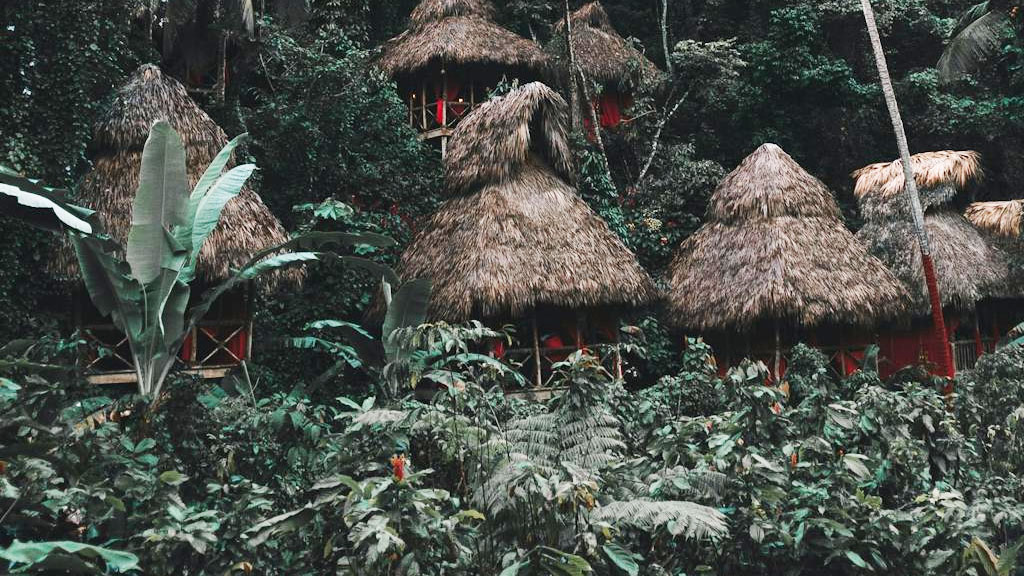Exploring Tropical Gardens
Tropical botanical gardens offer vibrant landscapes filled with diverse plant species that inspire homeowners seeking serene garden spaces. Here, we explore three notable gardens that highlight the beauty and significance of tropical plants.
The U.S. Botanic Garden
Located in Washington, D.C., the U.S. Botanic Garden celebrates the plant diversity of the United States. Visitors can explore an array of ecosystems, from arid deserts to lush tropical forests within the stunning Conservatory. This facility features collections that include vibrant orchids and other tropical plants, providing a feast for the eyes.
One of the highlights is the Children’s Garden which encourages young visitors to engage with nature through activities such as planting, watering, and digging. It’s an excellent way to foster a love for gardening in the next generation. The Children’s Garden is set to open for the 2024 season, making it a great time for families to plan their visit.
| Feature | Description |
|---|---|
| Location | Washington, D.C. |
| Plant Types | Native U.S. species, tropical plants, arid desert flora |
| Special Attractions | Conservatory, Children’s Garden |
Royal Botanic Gardens in Kew
The Royal Botanic Gardens in Kew, England, is a UNESCO World Heritage Site and stands as one of the most famous botanical gardens in the world. Known for its vast collection of plants, Kew Gardens spans 330 acres and hosts over 50,000 living plants, showcasing a remarkable variety of tropical species.
Kew’s various glasshouses, including the iconic Palm House and the new Hive, are home to countless tropical plants. Additionally, these gardens emphasize education and conservation, making them a wonderful place for anyone interested in plant sciences. The stunning landscapes and educational opportunities can inspire homeowners to incorporate similar planting techniques in their own gardens.
| Feature | Description |
|---|---|
| Location | Kew, England |
| Size | 330 acres |
| Plant Collection | Over 50,000 living plants |
Botanical Gardens in India
Botanical gardens in India are historically significant, with roots tracing back to at least 546 B.C. These gardens have witnessed periods of decline and resurgence, particularly since India’s independence. They serve as botanical research centers, conservation areas for rare species, and educational hubs for the public (GeeksforGeeks).
Notable gardens like the Lalbagh Botanical Garden in Bangalore and the Howrah Botanical Garden are filled with an array of tropical flora. These gardens not only celebrate the rich biodiversity of the region but also serve as crucial sites for taxonomic studies and conservation efforts. Homeowners looking to cultivate similar lush environments can draw inspiration from these diverse collections.
| Feature | Description |
|---|---|
| Historical Significance | Established in ancient times, with influences in Sanskrit literature |
| Notable Gardens | Lalbagh, Howrah Botanical Garden |
| Functions | Research, conservation, education |
Each of these tropical botanical gardens showcases the beauty and diversity of tropical plants, providing inspiration for homeowners looking to create their own peaceful garden spaces. For those seeking local gardens, exploring botanical gardens near me may reveal similar lush atmospheres in their area.
Significance of Botanic Gardens
Botanic gardens serve vital roles in various aspects of environmental science, conservation, and community enrichment. Each garden provides unique advantages, from taxonomic studies to economic contributions and global biodiversity preservation.
Taxonomic Studies and Conservation
Botanic gardens play an essential role in taxonomic studies and the conservation of rare plant species. They house approximately 105,209 of the 350,699 known plant species, representing about 30% of recognized species worldwide (In Defense of Plants). These gardens are critical in cultivating nearly half of all known threatened plant species but currently allocate only 10% of their space for this purpose.
| Aspect | Details |
|---|---|
| Total Global Plant Species | 350,699 |
| Species in Botanic Gardens | 105,209 |
| Percentage Represented | 30% |
Botanic gardens also conduct botanical research, helping to enhance knowledge about plant taxonomy, ecology, and their relationships within diverse ecosystems.
Economic Contributions
In addition to their scientific contributions, botanic gardens significantly impact the economy by creating job opportunities and supporting the horticultural industry. Besides providing employment in garden maintenance and educational roles, they attract visitors, leading to increased revenue for local businesses. The presence of botanical gardens can enhance property values in nearby areas, making them valuable resources for the communities they serve.
| Economic Impact | Details |
|---|---|
| Job Opportunities | Various roles in horticulture and education |
| Local Business Revenue | Increases due to tourism and events |
The gardens also play a role in promoting sustainable practices within the horticulture industry, thereby contributing to environmental conservation.
Global Biodiversity Preservation
Botanic gardens are essential for preserving global biodiversity. They cultivate more than 6 million living plant accessions, representing around 80,000 taxa, which equates to about a quarter of vascular plant species globally (PMC). This comprehensive collection aids in the exploration and preservation of global plant diversity.
| Biodiversity Preservation | Details |
|---|---|
| Total Living Plant Accessions | 6 million |
| Represented Taxa | 80,000 |
| Approximate Vascular Plant Species | 25% |
By providing a sanctuary for rare and endangered plants, botanic gardens serve as key players in ex situ conservation efforts, ensuring that many species continue to thrive beyond their natural habitats. These contributions underscore the importance of tropical botanical gardens in supporting both ecological and community health. Homeowners seeking inspiration may find visiting botanical gardens near me to explore these magical spaces beneficial. Additionally, those planning special events can consider botanical gardens for weddings as beautiful venues.
Unique Features of Key West Garden
The Key West Tropical Forest & Botanical Garden is renowned for its unique characteristics, making it a special destination among tropical botanical gardens. This garden not only provides serenity but also plays an invaluable role in conservation and education regarding native plant species.
Frost-Free Conservation Habitat
This tropical garden holds the distinction of being the only frost-free, subtropical natural conservation habitat in the continental United States. With a set of three freshwater ponds, the garden creates an ideal environment for a variety of plant species to thrive. The frost-free nature ensures that diverse flora can be cultivated year-round, showcasing the beauty of tropical species without the threat of cold damage. This aspect provides inspiration for homeowners seeking to create resilient and lush garden spaces. For those looking for garden spaces to explore, check out botanical gardens near me.
Conservation of Endangered Flora
The Key West Tropical Forest & Botanical Garden serves as a sanctuary for many endangered and threatened plants and animals. It emphasizes the significance of preserving native species, advocating educational initiatives that raise awareness about the importance of biodiversity. This commitment to conservation not only enhances ecological balance but provides a model for homeowners interested in promoting sustainability in their own gardens. The garden’s focus on cultivating threatened species from South Florida, Cuba, and the Caribbean illustrates the beauty and necessity of conserving our natural heritage. More insights can be found in our article on famous botanical gardens.
Native Species Cultivation
Key West’s garden emphasizes the historical significance of flora native to the region, actively engaging in the cultivation of local plant species. By showcasing these plants, the garden highlights their importance in maintaining the ecosystem and supports local wildlife. Homeowners who wish to incorporate native plants into their gardens can benefit from the knowledge and resources available in such botanical gardens. They not only provide beauty but also contribute to local biodiversity and ecosystem health—vital components for creating enjoyable and environmentally friendly garden spaces. For those planning events, consider the charm offered by botanical gardens for weddings.
The Key West Tropical Forest & Botanical Garden stands as a remarkable example of how tropical botanical gardens can inspire and educate, while actively contributing to conservation efforts and the appreciation of native plant life.
World’s Remarkable Botanical Gardens
Exploring some of the most captivating botanical gardens around the globe can inspire homeowners to create beautiful and serene garden spaces. Here are three remarkable examples: Sydney’s Royal Botanic Gardens, Singapore’s Botanic Gardens, and the Cape Town Botanical Garden.
Sydney’s Royal Botanic Gardens
The Royal Botanic Gardens in Sydney, Australia, opened its doors in 1816 and encompasses 74 acres. It is recognized as one of the most significant historical botanical institutions worldwide (Easy Grow).
Key Features:
| Feature | Description |
|---|---|
| Established | 1816 |
| Area | 74 acres |
| Importance | Historic botanical institution |
Visitors can enjoy an array of native and exotic plant species, as well as stunning views of Sydney Harbour. This garden serves as an excellent example for homeowners to consider native plants that thrive in their local climates.
Singapore’s Botanic Gardens
The Singapore Botanic Gardens is a preserved landscape that exemplifies a British tropical botanic garden. This garden has played a vital role in advancing scientific knowledge, especially in tropical botany and horticulture (UNESCO).
Key Features:
| Feature | Description |
|---|---|
| Landscape Design | Preserved British tropical style |
| Scientific Contribution | Focus on tropical botany and horticulture |
This lush garden offers an inspiring setting for homeowners, showcasing how to effectively integrate tropical plants into residential landscapes.
Cape Town Botanical Garden
Established in 1913, the Cape Town Botanical Garden in South Africa spans 89 acres and focuses on cultivating indigenous plants for conservation purposes. The garden features a variety of collections, including proteas, and houses a conservatory exhibiting plants from different regions like savanna, fynbos, and karoo (Easy Grow).
Key Features:
| Feature | Description |
|---|---|
| Established | 1913 |
| Area | 89 acres |
| Collection Focus | Indigenous plants |
Homeowners can draw inspiration from the diverse plant species showcased here, especially those suited for specific local climates and conservation efforts.
These tropical botanical gardens not only offer serene environments but also serve as valuable resources for homeowners looking to create garden spaces that are both beautiful and sustainable. For more ideas, consider exploring botanical gardens near me or checking out the best botanical gardens in the US.

